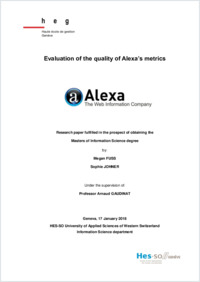Evaluation of the quality of Alexa’s metrics
SONAR|HES-SO
-
2018
61 p.
English
Alexa is a tool that can easily be confused by name with the voice device that Amazon proposes, but in reality, it is a web traffic tool. Very little is known about how it functions and where it gets data from. With so little information available, how is it possible to know whether the tool is of good value or not. The ability to compare Alexa with other tools such as Google Analytics gives insight into the quality of metrics and makes it possible to judge its transparency, reliability, trustworthiness and flexibility. To achieve this a state of the art on the subject was held, portraying elements relative to the metrics, the tools and the methods, this gave a direction in which to take the study. This lead the way to a much more practical side of the project, actually dealing with and assessing data. With a call being sent out to multiple networks, a sample of 10 websites was created, they all varied greatly but they also held important information that would help answer the research questions. A strict work methodology was undertaken to ensure the data would not be tainted and that it remained usable in order to facilitate the analysis of the data, it also ensured no backtracking would be necessary. The findings were not as striking as expected, as some results were more similar than originally predicted, although the correlation between the numbers was very low. Hardly any websites from the sample presented results that were constantly similar, albeit one, there was also one metric that would have data that bore no resemblance between the different tools. In addition to the results emitted by the data and charts numerous limitations attached to the tools were identified and it was obvious that they added challenges into giving conclusive results. Even though Alexa presents itself to be a useful tool to the everyday individual it does have quite a few limitations that a more consequent tool does not possess. There are evidently also improvements to be made when it comes to the standardization of such tools in order to make their use easier for all. Not all the results found in this study were conclusive but the door is open for a more in-depth project that would answer the additional questions that came up.
- Language
-
- English
- Classification
- Information, communication and media sciences
- Series statement
-
- Travail de recherche réalisé dans le cadre du Master of Science HES-SO en Sciences de l'information à la Haute école de gestion de Genève (HEG-GE), Filière Information documentaire, 2018
- Notes
-
- Haute école de gestion Genève
- Filière information documentaire
- hesso:hegge
- License
- License undefined
- Identifiers
-
- RERO DOC 309481
- REPORT NUMBER TRMASID 15
- Persistent URL
- https://roar.hep-bejune.ch/global/documents/314633
Statistics
Document views: 76
File downloads:
- TRMASID_15_Fuss_Johner_.pdf: 160
